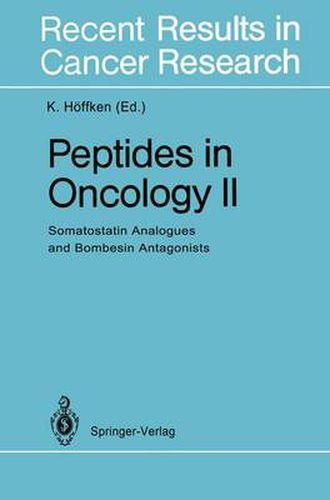Readings Newsletter
Become a Readings Member to make your shopping experience even easier.
Sign in or sign up for free!
You’re not far away from qualifying for FREE standard shipping within Australia
You’ve qualified for FREE standard shipping within Australia
The cart is loading…






This title is printed to order. This book may have been self-published. If so, we cannot guarantee the quality of the content. In the main most books will have gone through the editing process however some may not. We therefore suggest that you be aware of this before ordering this book. If in doubt check either the author or publisher’s details as we are unable to accept any returns unless they are faulty. Please contact us if you have any questions.
Controlled and predictable interference with hormonal feed- back mechanisms has become a major direction of preclinical and clinical research. There is a steadily increasing number of hormonal pep tides detected and characterized that are re- sponsible for endo-, para-, and autocrine cellular actions. Naturally, these peptides have been studied with regard to their cell growth stimulatory action and, in parallel, the re- spective antagonists are being investigated in terms of their antiproliferative (antineoplastic) function. Among the numerous pep tides of interest in this respect, somatostatin (somatotropin release inhibitory factor) and bombesin antagonizing factors have been the topic of inten- sive research during recent years. No presentation of the role of pep tides in oncology would be complete without a compre- hensive treatise of their physiological, preclinical and clinical functions in the context of their antineoplastic mechanism of action. Somatostatin and its various short- and long-acting analogs have the unique feature of suppressing and inhibiting a wide range of cellular processes including cell proliferation. Recep- tors for these peptides, which belong in a wider sense to the family of neuropeptides or neurotransmitters, are widely dis- tributed, a feature which is not in keeping with the general view of a growth hormone regulatory system. Thus, these substances are found in the gut in a variety of endocrine and exocrine glands including breast, pancreas, and prostate, and in the nervous system.
$9.00 standard shipping within Australia
FREE standard shipping within Australia for orders over $100.00
Express & International shipping calculated at checkout
This title is printed to order. This book may have been self-published. If so, we cannot guarantee the quality of the content. In the main most books will have gone through the editing process however some may not. We therefore suggest that you be aware of this before ordering this book. If in doubt check either the author or publisher’s details as we are unable to accept any returns unless they are faulty. Please contact us if you have any questions.
Controlled and predictable interference with hormonal feed- back mechanisms has become a major direction of preclinical and clinical research. There is a steadily increasing number of hormonal pep tides detected and characterized that are re- sponsible for endo-, para-, and autocrine cellular actions. Naturally, these peptides have been studied with regard to their cell growth stimulatory action and, in parallel, the re- spective antagonists are being investigated in terms of their antiproliferative (antineoplastic) function. Among the numerous pep tides of interest in this respect, somatostatin (somatotropin release inhibitory factor) and bombesin antagonizing factors have been the topic of inten- sive research during recent years. No presentation of the role of pep tides in oncology would be complete without a compre- hensive treatise of their physiological, preclinical and clinical functions in the context of their antineoplastic mechanism of action. Somatostatin and its various short- and long-acting analogs have the unique feature of suppressing and inhibiting a wide range of cellular processes including cell proliferation. Recep- tors for these peptides, which belong in a wider sense to the family of neuropeptides or neurotransmitters, are widely dis- tributed, a feature which is not in keeping with the general view of a growth hormone regulatory system. Thus, these substances are found in the gut in a variety of endocrine and exocrine glands including breast, pancreas, and prostate, and in the nervous system.